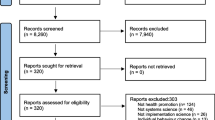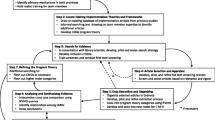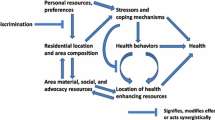Abstract
Background
Dissemination and implementation (D&I) research seeks to understand and overcome barriers to adoption of behavioral interventions that address complex problems, specifically interventions that arise from multiple interacting influences crossing socio-ecological levels. It is often difficult for research to accurately represent and address the complexities of the real world, and traditional methodological approaches are generally inadequate for this task. Systems science methods, expressly designed to study complex systems, can be effectively employed for an improved understanding about dissemination and implementation of evidence-based interventions.
Purpose
The aims of this study were to understand the complex factors influencing successful D&I of programs in community settings and to identify D&I challenges imposed by system complexity.
Method
Case examples of three systems science methods—system dynamics modeling, agent-based modeling, and network analysis—are used to illustrate how each method can be used to address D&I challenges.
Results
The case studies feature relevant behavioral topical areas: chronic disease prevention, community violence prevention, and educational intervention. To emphasize consistency with D&I priorities, the discussion of the value of each method is framed around the elements of the established Reach Effectiveness Adoption Implementation Maintenance (RE-AIM) framework.
Conclusion
Systems science methods can help researchers, public health decision makers, and program implementers to understand the complex factors influencing successful D&I of programs in community settings and to identify D&I challenges imposed by system complexity.




Similar content being viewed by others
References
Holmes BH, Finegood DT, Riley BL, Best A. Systems thinking in dissemination and implementation research. In: Brownson RC, Colditz GA, Proctor EK, editors. Dissemination and implementation research in health. NY: Oxford University Press; 2012. p. 175–91.
Hammond RA. Complex systems modeling for obesity research. Prev Chron Dis. 2009;63:A97.
Milstein B, Homer J, Briss P, Burton D, Pechacek T. Why behavioral and environmental interventions are needed to improve health at lower cost. Health Aff (Millwood). 2011;30(5):823–32.
Auchincloss AH, Diez Roux AV. A new tool for epidemiology? The usefulness of dynamic agent models in understanding place effects on health. Am J Epidemiol. 2008;168(1):1–8.
Caulkins JP. The need for dynamic drug policy. Addiction. 2007;102:4–7.
Luke DA, Stamatakis KA. Systems science methods in public health: dynamics, networks, and agents. Annu Rev Public Health. 2012;33:357–76. doi:10.1146/annurev-publhealth-031210-101222. Review.
Glasgow RE, Vogt TM, Boles SM. Evaluating the public health impact of health promotion interventions: the RE-AIM framework. Am J Public Health. 1999;89:1322–7.
Tabak RG, Khoong EC, Chambers DA, Brownson RC. Bridging research and practice: models for dissemination and implementation research. Am J Prev Med. 2012;43(3):337–50.
Homer JB, Hirsch GB. System dynamics modeling for public health: background and opportunities. Am J Public Health. 2006;96(3):452–8.
Vennix J. Group model building. New York: John Wiley & Sons; 1996.
Spielauer M. What is social science microsimulation? Soc Sci Comput Rev. 2011;29(1):9–20. doi:10.1177/0894439310370085.
Homer J, Milstein B, Wile K, Pratibhu P, Farris R, Orenstein D. Modeling the local dynamics of cardiovascular health: Risk factors, context, and capacity. Prev Chron Dis. 2008; 5(2).
Levy DT, Tworek C, Hahn EJ, Davis RE. The Kentucky SimSmoke tobacco policy simulation model: reaching healthy people 2010 goals through policy change. South Med J. 2008;101(5):503–7.
Homer J, Milstein B, Wile K, Trogden J, Huang P, Labarthe D. Simulating and evaluating local interventions to improve cardiovascular health. Prev Chron Dis. 2010; 7(1).
Loyo HK, Batcher C, Wile K, Huang P, Orenstein D, Milstein B. From model to action: using a system dynamics model of chronic disease risks to align community action. Health Promot Pract. 2013;14(1):53–61.
Helbing D, Balietti. Agent-based modeling. In: Helbing D, editor. Social Self-Organization. Berlin: Springer-Verlag, 2012. p. 25–70.
Brown ST, Tai JHY, Bailey RR, Cooley PC, Wheaton WD, Potter MA, et al. Would school closure for the 2009 H1N1 influenza epidemic have been worth the cost?: a computational simulation of Pennsylvania. BMC Public Health. 2011;11:353.
Lee BY, Brown ST, Cooley PC, Zimmerman RK, Wheaton WD, Zimmer SM, et al. A computer simulation of employee vaccination to mitigate an influenza epidemic. Am J Prev Med. 2010;38(3):247–57.
Lee BY, Brown ST, Korch GW, Cooley PC, Zimmerman RK, Wheaton WD, et al. A computer simulation of vaccine prioritization, allocation, and rationing during the2009 H1N1 influenza pandemic. Vaccine. 2010;28(31):4875–9.
Bahr DB, Browning RC, Wyatt HR, Hill JO. Exploiting social networks to mitigate the obesity epidemic. Obesity. 2009;17(4):723–8.
Auchincloss AH, Riolo RL, Brown DG, Cook J, Diez Roux AV. An agent-based model of income inequalities in diet in the context of residential segregation. Am J Prev Med. 2011;40(3):303–11.
Yonas MA, Borrebach JD, Burke JG, Brown ST, Philp KD, Burke DS. Dynamic simulation of community crime and crime-reporting behavior. In: Proceedings of the 2011 International Conference on Social Computing, Behavioral-Cultural Modeling, & Prediction (SBP11) College Park, MD, 2011.
Axtell R, Durlauf S, Epstein JM, Hammond RA, Klemens B, Parker J. Social influences and smoking behavior. Technical report, A report from the Center on Social and Economic Dynamics, 2006.
Gorman DM, Mezic J, Mezic I, Gruenewald PG. Agent-based modeling of drinking behavior: a preliminary model and potential application to theory and practice. Am J Public Health. 2006;96:2055–60.
Nagoski E, Janssen E, Lohrmann D, Nichols E. Risk, individual differences, and environment: an Agent-Based Modeling approach to sexual risk-taking. Arch Sex Behav. 2012;41(4):849–60.
Yonas M, Burke JG, Brown S, Borrebach J, Garland R, Burke DS, et al. Dynamic simulation of crime perpetration and reporting to examine community intervention strategies. Health Educ Behav. 2013;40(1 Suppl):87S–97.
Ajzen I. Understanding attitudes and predicting social behavior. Englewood Cliffs, N.J: Prentice-Hall; 1980.
Mulvey EP, Steinberg L, Fagan J, Cauffman E, Piquero AR, Chassin L, et al. Theory and research on desistance from antisocial activity among serious adolescent offenders. Youth Violence Juvenile Justice. 2004;2(3):213–36.
Marsden PV. Network data and measurement. Annu Rev Sociol. 1990;16:435–63.
Marsden PV. Survey methods for network data. In: Scott J, Carrington PJ, editors. The SAGE handbook of social network analysis. London: Sage; 2011. p. 370–88.
Wasserman S, Faust K. Social network analysis: methods and applications. Cambridge: Cambridge University Press; 1994.
Snijders TA. Models for longitudinal network data. In: Carrington PJ, Scott J, Wasserman S, editors. Models and methods in social network analysis. New York: Cambridge University Press; 2005. p. 215–47.
Hawe P, Ghali L. Use of social network analysis to map the social relationships of staff and teachers at school. Health Educ Res. 2008;23:62–9.
Neal JW, Shernoff ES, Frazier SL, Stachowicz E, Frangos R, Atkins MS. Change from within: engaging teacher key opinion leaders in the diffusion of interventions in urban schools. Community Psychol. 2008;41:53–7.
Provan KG, Veazie MA, Staten LK, Teufel-Shone NI. The use of network analysis to strengthen community partnerships. Public Adm Rev. 2005;65:603–13.
Dearing JW. Evolution of diffusion and dissemination theory. J Public Health Manag Pract. 2008;14:99–108.
Rogers EM. Diffusion of innovations (5th edition). New York: Free Press; 2003.
Valente TW. Network models of the diffusion of innovations. Cresskill, NJ: Hampton Press Inc.; 1995.
Neal JW, Neal ZP, Atkins MS, Henry DB, Frazier SL. Channels of change: contrasting network mechanisms in the use of interventions. Am J Community Psychol. 2011;47:277–86.
Burt RS. The social capital of opinion leaders. Annals AAPSS. 1999;566:37–54.
Acknowledgments
Diane R. Orenstein, we would like to recognize and sincerely thank you for your help conceptualizing the manuscript and for the feedback on multiple drafts. We would also like to acknowledge and thank the following people for their contributions to the projects presented: John Grefenstette, Richard Garland, Shawn Brown, Jeffrey Borrebach, and Donald Burke (agent-based modeling) and Patricia Farrell, Marvin McKinney, Giannina Fehler-Cabral, Patrick Janulis, Gabriela Saenz, and staff at the five PAS elementary schools (network analysis). The agent based modeling research reported in this publication was supported by the National Institute Of General Medical Sciences of the National Institutes of Health under Award Number U54 GM088491.
Conflict of interest
Authors Jessica G. Burke, Kristen Hassmiller Lich, Jennifer Watling Neal, Helen I. Meissner, Michael Yonas, and Patricia L. Mabry declare that they have no conflict of interest. The content of this paper is solely the responsibility of the authors and does not necessarily represent the official views of the National Institutes of Health or the Centers for Disease Control and Prevention.
Human subjects
All procedures followed were in accordance with the ethical standards of the responsible committee on human experimentation (institutional and national) and with the Helsinki Declaration of 1975, as revised in 2000. If required by the Institutional Review Board, informed consent was obtained from all patients for being included in the studies presented.
Author information
Authors and Affiliations
Corresponding author
Rights and permissions
About this article
Cite this article
Burke, J.G., Lich, K.H., Neal, J.W. et al. Enhancing Dissemination and Implementation Research Using Systems Science Methods. Int.J. Behav. Med. 22, 283–291 (2015). https://doi.org/10.1007/s12529-014-9417-3
Published:
Issue Date:
DOI: https://doi.org/10.1007/s12529-014-9417-3




